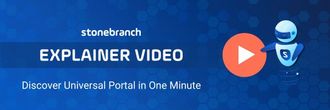What are Infrastructure Automation and Orchestration Tools?
Infrastructure automation and orchestration tools streamline IT operations by automating and orchestrating infrastructure management, offering solutions for agility, reliability, and scalability.

Infrastructure automation and orchestration (IA&O) tools are emerging as an essential component in the IT toolkit. They enable organizations to navigate the complexities of modern IT environments. These tools offer a seamless way to manage the provisioning, deployment, and operation of infrastructure resources. Ultimately, IA&O tools ensure that businesses can keep pace with the demands of innovation and growth.
But what are IA&O tools, really? And how do you choose the right one for your needs? Let's take a closer look.
The Significance of IA&O in Modern IT
Infrastructure and operations (I&O) leaders are constantly faced with the daunting task of provisioning, deploying, and managing infrastructure resources. They aim to achieve agility, reliability, and scalability in delivering IT services. Traditional manual processes can no longer keep up in an environment where speed and efficiency are paramount.
This is where IA&O tools come into play, offering a lifeline to organizations looking to streamline their IT operations. In their 2024 Market Guide for Infrastructure Automation and Orchestration Tools, Gartner notes that "adoption of infrastructure orchestration represents a maturity improvement for organizations seeking to increase the depth and breadth of infrastructure services they deliver."
Steady growth in the infrastructure automation market reflects the improvement in organizational maturity. Gartner states, "[The infrastructure automation market] increased from an estimated $743.5 million in 2021 to $860.1 million in 2022, representing 15.6% growth. This market is expected to continue to increase to an estimated $1.1 billion by 2027, with a compound annual growth rate (CAGR) of 6%."
What is an Infrastructure Automation and Orchestration Tool?
Gartner defines IA&O tools as solutions that enable I&O teams to design, implement, and manage a broad range of reusable infrastructure services. These tools are pivotal in building the foundations for infrastructure platform engineering (IPE) capabilities. They provide automated infrastructure delivery and operations across hybrid IT environments.
Hybrid IT environments include public cloud infrastructure (for example, AWS and Azure), on-premises servers, and private cloud (for example, virtual machines).

The illustration above highlights how the many components of an IA&O tool come together to help enhance:
- Security and compliance policy enforcement
- Cost optimization
- Delivery and operational metrics
- Visibility of delivered infrastructure
Features of an IA&O Tool, According to Gartner
Key features of IA&O tools, as identified by Gartner, include:
- Provisioning Automation: hybrid infrastructure deployment across on-premises and cloud environments, including infrastructure-as-code (IaC), an extensible library of integrations, and role-based access control.
- Configuration Automation: deployment automation, managing the configuration of deployed systems, operational automation for deployed services, plus integration with security, testing, and cost-optimization tools.
- Infrastructure Orchestration: executing complex delivery and operational workflows with pre-defined (supplied and user-generated) templates, API access for deployment, and a catalog of integrations to common infrastructure tools.
Collectively, these features enable organizations to improve operational efficiency, quality, policy compliance, risk mitigation, and cost and process optimization.
Additional key features to look for include ease of use, scalability, support for multiple cloud platforms, comprehensive monitoring, version control, and a strong community for support and resources.
Orchestration Across the Organization
An IA&O tool's orchestration engine is designed to handle complex IT workflows. Automated workflows that involve infrastructure orchestration are pervasive across multiple departments.
End-users within an enterprise typically break down into two types:
- For I&O teams, infrastructure orchestration enables greater staff efficiencies by automating routine tasks. However, automating their own I&O tasks isn't the only end goal. Enabling consumers of infrastructure with automation-as-a-service is the key to scalability.
- Across the rest of the organization, consumers of infrastructure services are empowered with self-service automation to control infrastructure workflows. End-users interact via chat communication tools, helpdesk tickets, jobs-as-code, and self-service portals.
Outside of ITOps, teams that require access to IA&O tools include:
- DataOps
- DevOps
- MLOps
- CloudOps
- PlatformOps
- Business Users
By breaking down silos and fostering collaboration, IA&O tools significantly reduce the friction between teams. Additionally, a centralized platform lowers the cognitive load on developers and embeds security and compliance into all IT operations.
Conclusion
The ability to rapidly provision, deploy, and manage IT infrastructure is not just an operational necessity but a strategic advantage. Infrastructure automation and orchestration tools like Stonebranch Universal Automation Center (UAC) enable this agility. UAC offers a pathway to optimized IT operations that are both efficient and scalable. Curious to see how Stonebranch's own CloudOps team uses UAC to provision cloud resources? Watch the video to learn how.
Frequently Asked Questions
What is infrastructure automation and orchestration?
Infrastructure automation and orchestration refers to the use of tools and processes to automate and streamline the management of IT infrastructure, allowing for more efficient and consistent provisioning, deployment, and monitoring of resources.
What is the difference between infrastructure automation and orchestration?
Infrastructure automation focuses on automating individual tasks, while orchestration involves coordinating and managing multiple automated tasks as processes to work together as a cohesive system.
How does infrastructure automation and orchestration help with workload automation?
By automating tasks such as provisioning, deployment, and scaling, these tools help manage workloads more efficiently and ensure resources are allocated optimally based on demand.
Start Your Automation Initiative Now
Schedule a Live Demo with a Stonebranch Solution Expert






